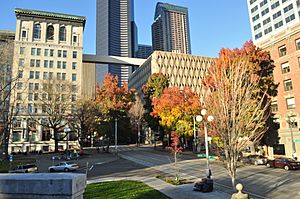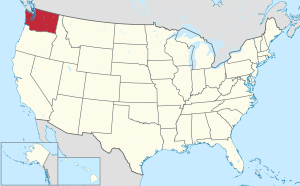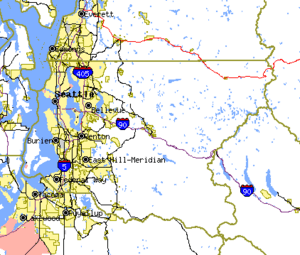King County, Washington facts for kids
Quick facts for kids
King County
|
|||
|---|---|---|---|

City Hall Park and King County Courthouse in downtown Seattle
|
|||
|
|||

Location within the U.S. state of Washington
|
|||
 Washington's location within the U.S. |
|||
| Country | |||
| State | |||
| Founded | December 22, 1852 | ||
| Named for |
|
||
| Seat | Seattle | ||
| Largest city | Seattle | ||
| Area | |||
| • Total | 2,307 sq mi (5,980 km2) | ||
| • Land | 2,116 sq mi (5,480 km2) | ||
| • Water | 191 sq mi (490 km2) 8.3% | ||
| Population
(2020)
|
|||
| • Total | 2,269,675 | ||
| • Estimate
(2023)
|
2,271,380 |
||
| • Density | 983.82/sq mi (379.86/km2) | ||
| Time zone | UTC−8 (Pacific) | ||
| • Summer (DST) | UTC−7 (PDT) | ||
| Congressional districts | 1st, 7th, 8th, 9th | ||
King County is a county located in the U.S. state of Washington. The population was 2,269,675 in the 2020 census, making it the most populous county in Washington, and the 12th-most populous in the United States. The county seat is Seattle, also the state's most populous city.
Originally named after US representative, senator, and then vice president-elect William R. King in 1852, the county government amended its designation in 1986 to honor Martin Luther King Jr., a prominent activist and leader during the civil rights movement. The change was approved by the state government in 2005.
It is one of three Washington counties that are included in the Seattle–Tacoma–Bellevue metropolitan statistical area along with Snohomish County to the north and Pierce County to the south. About two-thirds of King County's population lives in Seattle's suburbs, which largely developed in the late 20th century and early 21st century as bedroom communities before becoming job centers for the technology industry.
History
When Europeans arrived in the region that would become King County, it was inhabited by several Coast Salish groups. Villages around the site that would become Seattle were primarily populated by the Duwamish people. The Snoqualmie Indian Tribe occupied the area that would become eastern King County. The Green River and White River were home for the Muckleshoot tribal groups. In the first winter after the Denny Party landed at Alki Point, the settlement at the point consisted of a few dozen settlers and over a thousand Native Americans. The local tribes provided the settlers with construction labor, domestic service, and help with subsistence activities.
On December 22, 1852, the Oregon Territory legislature formed King County out of territory from within Thurston County. The county was named after Alabamian William R. King, who had just been elected Vice President of the United States under President Franklin Pierce. Seattle was made the county seat on January 11, 1853. The area became part of the Washington Territory when it was created later that year.
King County originally extended to the Olympic Peninsula. According to historian Bill Speidel, when peninsular prohibitionists threatened to shut down Seattle's saloons, Doc Maynard engineered a peninsular independence movement; King County lost what is now Kitsap County but preserved its entertainment industry.
Coal was discovered in 1853 by M. Bigelow along the Black River, and in subsequent decades several companies formed to mine coal around Lake Washington and deliver it to Seattle. The Seattle and Walla Walla Railroad started servicing the Renton coal fields in 1877, and the Newcastle fields in 1878. By 1880, King County produced 22% of the coal mined on the West Coast, most of that coal being found within the Renton Formation's Muldoon coal seam.
Name
On February 24, 1986, the King County Council approved a motion to rename the county to honor civil rights leader Martin Luther King Jr. (no relation to William R. King), preserving the name "King County" while changing its namesake. The motion stated, among other reasons for the change, that "William Rufus DeVane King was a slaveowner" who "earned income and maintained his lifestyle by oppressing and exploiting other human beings," while Martin Luther King's "contributions are well-documented and celebrated by millions throughout this nation and the world, and embody the attributes for which the citizens of King County can be proud, and claim as their own."
Because only the state can charter counties, the change was not made official until April 19, 2005, when Governor Christine Gregoire signed into law Senate Bill 5332, which provided that "King county is renamed in honor of the Reverend Doctor Martin Luther King, Jr." effective July 24, 2005.
The County Council voted on February 27, 2006, to adopt the proposal sponsored by Councilmember Larry Gossett to change the county's logo from an imperial crown to an image of Martin Luther King Jr. On March 12, 2007, the new logo was unveiled. The new logo design was developed by the Gable Design Group and the specific image was selected by a committee consisting of King County Executive Ron Sims, Council Chair Larry Gossett, Prosecutor Norm Maleng, Sheriff Sue Rahr, District Court Judge Corrina Harn, and Superior Court Judge Michael Trickey. The same logo is used in the flag.
Martin Luther King Jr. had visited King County once, for three days in November 1961.
Geography
According to the United States Census Bureau, the county has a total area of 2,307 square miles (5,980 km2), of which 2,116 square miles (5,480 km2) is land and 191 square miles (490 km2) (8.3%) is water. King County has nearly twice the land area of the state of Rhode Island. The highest point in the county is Mount Daniel at 7,959 feet (2,426 meters) above sea level.
King County borders Snohomish County to the north, Kitsap County to the west, Kittitas County to the east, and Pierce County to the south. It also shares a small border with Chelan County to the northeast. King County includes Vashon Island and Maury Island in Puget Sound.
The county has 760 lakes and 3,000 miles (4,800 km) of streams and rivers.
Geographic features

Terrain
- Cascade Range
- Issaquah Alps
- Mount Baker-Snoqualmie National Forest
- Mount Daniel, the highest point
- Mount Si
- Harbor Island
- Maury Island
- Mercer Island
- Sammamish Plateau
- Vashon Island
Water
National protected areas
- Klondike Gold Rush National Historical Park (part, also in Skagway, Alaska)
- Snoqualmie National Forest (part)
Climate change
King County has been identified as vulnerable to higher risks of flooding caused by climate change due to the number of waterways in the area. The county's oceanic ecosystems are predicted to face harmful chemical changes, while the mountainous ecosystems could experience a decrease in ice and snow. Since the mid-2000s, the county government has adopted policies to mitigate the effects of climate change and reduce carbon dioxide emissions in the region.
Transportation
Major highways
Public transit
The King County Metro serves the county with local routes, paratransit, vanpools, and rideshare in select areas. It also operates an electric trolleybus network in Seattle as well as the city streetcar system. Metro was the seventh-largest transit bus agency in the United States by ridership in 2019, with 121.3 million annual passenger trips and 400,000 per weekday. Sound Transit manages Link light rail, Sounder commuter rail, and Sound Transit Express buses in King County that provide connections to adjacent counties. The Community Transit of Snohomish County and the Pierce Transit of Pierce County also operate routes that serve portions of King County. Most transit modes in the county use the ORCA card, a smart fare card system introduced in 2009.
The county is home to three major ferry terminals that are served by Washington State Ferries, a state-run passenger and automobile ferry system. Colman Dock in Downtown Seattle is served by routes from Bainbridge Island and Bremerton; Vashon Island is connected to West Seattle at Fauntleroy and also has service to Southworth in Kitsap County. The county government's Marine Division operates the King County Water Taxi, a passenger ferry service that connects Downtown Seattle to West Seattle and Vashon Island. The passenger-only Kitsap Fast Ferries system operated by Kitsap Transit connects a terminal near Colman Dock to communities on the Kitsap Peninsula.
Demographics
| Historical population | |||
|---|---|---|---|
| Census | Pop. | %± | |
| 1860 | 302 | — | |
| 1870 | 2,120 | 602.0% | |
| 1880 | 6,910 | 225.9% | |
| 1890 | 63,989 | 826.0% | |
| 1900 | 110,053 | 72.0% | |
| 1910 | 284,638 | 158.6% | |
| 1920 | 389,273 | 36.8% | |
| 1930 | 463,517 | 19.1% | |
| 1940 | 504,980 | 8.9% | |
| 1950 | 732,992 | 45.2% | |
| 1960 | 935,014 | 27.6% | |
| 1970 | 1,156,633 | 23.7% | |
| 1980 | 1,269,749 | 9.8% | |
| 1990 | 1,507,319 | 18.7% | |
| 2000 | 1,737,034 | 15.2% | |
| 2010 | 1,931,249 | 11.2% | |
| 2020 | 2,269,675 | 17.5% | |
| 2023 (est.) | 2,271,380 | 17.6% | |
| U.S. Decennial Census 1790–1960 1900–1990 1990–2000 2010–2020 |
|||
The center of population of the state of Washington in 2010 was located in eastern King County (47°19′51″N 121°37′12″W / 47.330750°N 121.619994°W). King County's own center of population was located on Mercer Island (47°32′54″N 122°13′48″W / 47.548320°N 122.229983°W).
As of the fourth quarter of 2021, the median home value in King County was $817,547, an increase of 19.6% from the prior year.
In 2021 King County experienced its first population decline in 50 years.
Racial and ethnic composition since 1960
| Racial composition | 2020 | 2010 | 2000 | 1990 | 1980 | 1970 | 1960 |
|---|---|---|---|---|---|---|---|
| White (non-Hispanic) | 54.2% | 64.8% | 73.4% | 83.2% | 87.2% | – | – |
| Asian (non-Hispanic) | 19.8% | 14.5% | 10.8% | 7.8% | – | – | 2.0% |
| Hispanic or Latino | 10.7% | 8.9% | 5.4% | 2.9% | 2.1% | 1.8% | – |
| Black or African American (non-Hispanic) | 6.5% | 6.0% | 5.4% | 5.0% | 4.4% | 3.5% | 2.9% |
| Pacific Islander (non-Hispanic) | 0.9% | 0.7% | 0.5% | – | – | – | – |
| Native American (non-Hispanic) | 0.5% | 0.7% | 0.9% | 1.1% | – | – | 0.3% |
| Mixed (non-Hispanic) | 6.8% | 4.1% | 4.0% | – | – | – | – |
2020 census
As of the 2020 census, there were 2,269,675 people, 917,764 households, and 537,466 families residing in the county. The population density was 1,073.0 inhabitants per square mile (414.3/km2) There were 969,234 housing units. The racial makeup of the county was 56.1% White (54.2% Non-Hispanic White), 6.7% African American (6.5% Non-Hispanic Black), 19.9% Asian (19.8% Non-Hispanic Asian), 0.9% Pacific Islander (0.8% Non-Hispanic Pacific Islander), 0.5% Native American, 5.2% from other races, and 10.4% from two or more races. Those of Hispanic or Latino origin made up 10.7% of the population.
2010 census
As of the 2010 census, there were 1,931,249 people, 789,232 households, and 461,510 families residing in the county. The population density was 912.9 inhabitants per square mile (352.5/km2). There were 851,261 housing units at an average density of 402.4 per square mile (155.4/km2). The racial makeup of the county was 68.7% White (64.8% Non-Hispanic White), 6.2% African American, 14.6% Asian, 0.8% Pacific Islander, 0.8% Native American, 3.9% from other races, and 5.0% from two or more races. Those of Hispanic or Latino origin made up 8.9% of the population. In terms of ancestry, 17.1% were German, 11.6% were English, 11.1% were Irish, 5.5% were Norwegian, and 2.9% were American.
Of the 789,232 households, 29.2% had children under the age of 18 living with them, 45.3% were married couples living together, 9.1% had a female householder with no husband present, 41.5% were non-families, and 31.0% of all households were made up of individuals. The average household size was 2.40 and the average family size was 3.05. The median age was 37.1 years.
The median income for a household in the county was $68,065 and the median income for a family was $87,010. Males had a median income of $62,373 versus $45,761 for females. The per capita income for the county was $38,211. About 6.4% of families and 10.2% of the population were below the poverty line, including 12.5% of those under age 18 and 8.6% of those age 65 or over.
Native American tribes
King County is home two federally-recognized tribes, the Muckleshoot tribe and the Snoqualmie Indian Tribe tribe, and other unrecognized groups. The Muckleshoot Indian Reservation is located southeast of Auburn and is home to a resident population of 3,606 as of the 2000 census.
The Snoqualmie tribe's casino property was federally recognized as their reservation in 2006, however few tribe members live near the reservation.
Religion
In 2010 statistics, the largest religious group in King County was the Archdiocese of Seattle, with 278,340 Catholics worshipping at 71 parishes, followed by 95,218 non-denominational adherents with 159 congregations, 56,985 LDS Mormons with 110 congregations, 25,937 AoG Pentecostals with 63 congregations, 25,789 ELCA Lutherans with 68 congregations, 24,909 PC-USA Presbyterians with 54 congregations, 18,185 Mahayana Buddhists with 39 congregations, 18,161 UMC Methodists with 50 congregations, 14,971 TEC Episcopalians with 35 congregations, and 12,531 ABCUSA Baptists with 42 congregations. Altogether, 37.6% of the population was claimed as members by religious congregations, although members of historically African-American denominations were underrepresented due to incomplete information. In 2014, King County had 944 religious organizations, the 8th most out of all US counties.
Homelessness
King County has the third largest population of homeless or unsheltered people in the United States according to the U.S. Department of Housing and Urban Development (HUD). The agency's January 2023 report, based on the point-in-time count system, estimates 14,149 people in the county have experienced homelessness; the King County Regional Homelessness Authority (KCRHA) adopted a different methodology based on the number of people seeking services and estimated that 53,532 people in the county had been homeless at some point in 2022. According to a survey collected by service providers for the county government, 68.5 percent of respondents said they last had stable housing in King County and 10.8 percent had lived elsewhere in the state. Approximately 57 percent of the homeless population counted by HUD in King County was classified as unsheltered, either living in vehicles, encampments in public spaces, or other places. The number of unsheltered individuals increased significantly in the late 2010s, leading to clearing of encampments and other structures by local governments.
The county has 5,115 emergency shelter beds and tiny house villages, of which 67 percent are in the city of Seattle. According to data from the KCRHA, since late 2022 over 90 percent of shelter beds have been occupied on a consistent basis. Additional shelters, parking lots, and encampment sites are operated by charity organizations and churches in the area; during severe weather events such as heat waves and cold snaps, local governments open additional shelter spaces, but these often reach capacity. In 2021, a total of $123 million was spent on homelessness services by local governments in King County, including cities and the regional authority. The regional authority's five-year plan, released in 2023, estimates that $8 billion in capital costs would be required to build and staff 18,205 new units of temporary and transitional housing to address the homelessness crisis.
Education
K–12 schools
School districts in the county include:
- Auburn School District
- Bellevue School District
- Enumclaw School District
- Federal Way Public Schools
- Fife Public Schools
- Highline School District
- Issaquah School District
- Kent School District
- Lake Washington School District
- Mercer Island School District
- Northshore School District
- Renton School District
- Riverview School District
- Seattle Public Schools
- Shoreline School District
- Skykomish School District
- Snoqualmie Valley School District
- Tahoma School District
- Tukwila School District
- Vashon Island School District
Public libraries
Most of King County is served by the King County Library System, with the exception of Seattle, Hunts Point, and Yarrow Point. The city of Seattle is served by the Seattle Public Library system, which has 27 branches compared to King County's 49 locations.
Communities
Cities
- Algona
- Auburn (partial)
- Bellevue
- Black Diamond
- Bothell (partial)
- Burien
- Carnation
- Clyde Hill
- Covington
- Des Moines
- Duvall
- Enumclaw
- Federal Way
- Issaquah
- Kenmore
- Kent
- Kirkland
- Lake Forest Park
- Maple Valley
- Medina
- Mercer Island
- Milton (partial)
- Newcastle
- Normandy Park
- North Bend
- Pacific (partial)
- Redmond
- Renton
- Sammamish
- SeaTac
- Seattle (county seat)
- Shoreline
- Snoqualmie
- Tukwila
- Woodinville
Towns
Census-designated places
- Ames Lake
- Baring
- Boulevard Park
- Bryn Mawr-Skyway
- Cottage Lake
- East Renton Highlands
- Fairwood
- Fall City
- Hobart
- Inglewood-Finn Hill (former)
- Klahanie (former)
- Lake Holm
- Lake Marcel-Stillwater
- Lake Morton-Berrydale
- Lakeland North
- Lakeland South
- Maple Heights-Lake Desire
- Mirrormont
- Ravensdale
- Riverbend
- Riverpoint
- Riverton (former)
- Shadow Lake
- Union Hill-Novelty Hill
- Vashon
- White Center
- Wilderness Rim
Other unincorporated communities
- Cedar Falls
- Cumberland
- Denny Creek
- Ernie's Grove
- Grotto
- Kanaskat
- Kangley
- Lake Joy
- Naco
- Novelty
- Palmer
- Preston
- Selleck
- Spring Glen
- Wabash
Former cities and towns
Ghost towns
See also
 In Spanish: Condado de King (Washington) para niños
In Spanish: Condado de King (Washington) para niños






